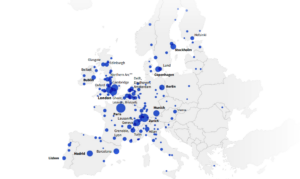Moving Away From The Parent-Child Relationship In Teams

Marin Petrov is a serial entrepreneur who left his dream job in the animation industry and founded two companies. One failed, but the other got acquired by Amazon. Prior to leaving the corporate world, Petrov had over 15 years of experience in the animations and special effects industry in Bulgaria and New York, being part of the team that drew the weird squirrel Scrat from Ice Age.
Most companies nowadays operate in the traditional top-down pyramidal way. There is a boss and there is a team. Decisions flow downwards and information flows upwards. This used to work many years ago when the nature of work was predictable and we used assembly lines to create products. Nowadays, most of the work is uncertain and unpredictable and this method of organizing is far less productive than it used to be 100 years ago. But above all, this way of working establishes and reinforces a certain unproductive mindset, which many people call the “parent-child” mindset.
Why is it unproductive? Because it teaches us to be complicit and removes the ability of the employees to solve problems when they arise. But if we want a team that is fully capable of accomplishing extraordinary results, we need to stop doing this. We need to move away from this “parent-child” relationship to a “peer to peer” relationship. To better illustrate how we can practically do this, I want to show you a framework. Think of it as a game where to go to the next level you need to first master the previous level. It will also be almost impossible to skip levels, you must become good at one and then move to the next. The key here is playing the game with your teammates. It’s not a single-player game and you can’t advance alone.
Stage 1 Teams

In this type of team, there is a well-defined hierarchy. Sometimes the hierarchy is many levels deep. The boss of the boss of the boss tells team members what to do and team members are blindly following the directions. In such a team, I can’t do anything that I think is right. I need to get approval first. Innovation is stifled even before it begins. Goals and directions are often unknown and sometimes conflicting. Team members fight for resources, promotions and for taking more control. There is almost no collaboration happening. Nobody trusts anyone. The higher someone is on the ladder, the more they can decide what they can do. Micromanagement is a way of being. Information and data are well guarded at the top.
Stage 2 Teams
Here we still have a well-defined hierarchy, but instead of having three bosses, there might be only one. Team members are still being told what to do, but not in the worst micro-managed type of way. Maybe they have the opportunity to at least decide when to come to work and go home. They are still required to fill timesheets and write a report of what they have done today. But they also have the opportunity to decide how to do their tasks, even if they can’t decide what tasks to work on. There is a tiny bit of forced collaboration happening – someone needs to finish a task that someone else started and too often will complain about it. Team members are not good at handling interpersonal relationships at all. They are afraid to speak up if something bothers them and often talk behind each other’s backs.
Stage 3 Teams
There is no boss here. There is a team leader. The team leader encourages everyone to be more independent, but the people on the team lack the attitude or knowledge to be as independent as the leader wishes them to be. Usually, the team leader is someone with a lot of knowledge and is well respected by everyone in the team. The team leader can usually pick up any task and do an outstanding job. Members are not required to fill any timesheets or to come to work at an exact time. The team leader believes that they can handle these things perfectly by themselves and gives them more control over what they do. Most goals are well defined, but team members struggle to sometimes come up with their own ways of achieving them, so they need guidance from the team leader. The team members ask for permission to do something using phrases like “May I do X?”. Sometimes though, they get stuck at not knowing what to do next and ask the team leader for input. Some information is still guarded at the top (like financials for example), but most of it is freely distributed throughout the team. Although the team doesn’t yet know how to interpret the data and information.
Stage 4 Teams
There are no bosses, and there is sometimes a team leader. Team members don’t ask for permission to do something. They say “I intend to do X. What do you think?” and ask their peers for advice. When they see something that doesn’t work, they actively work on fixing it. Team members have a questioning attitude. They can read and understand the data and the information that has been distributed to them and draw a conclusion from it. Financial information is visible by everyone on the team, but most of the time, salaries are not. Goals are usually clear, but sometimes a bit chaotic. There are clear personal goals and not very well defined and clear team goals. Team members are good at handling interpersonal issues and will call out someone that doesn’t perform well.
Stage 5 Teams

Fully independent teams without any power hierarchies. Everyone on the team knows who is good at what and who is bad at what. Sometimes the team elects a team leader and sometimes they don’t. In fact, the team itself has the power to change how the team operates. Team members actively help other team members to become better versions of themselves. There is a lot of mentoring and coaching and zero nagging and complaining. When someone makes a mistake, team members are very good at pointing this out and helping the team member improve in the area they are lacking. Everyone is fully capable of starting an initiative and leading it to completion. In different situations, different team members are leaders and followers. All the information is visible to everyone and the team knows how to read the data and make conclusions about what needs to be done. Not only salary information is visible by everyone, but team members also self-set their salaries. When a decision needs to be made, a team member knows if others will be affected by the decision and notify them by saying “I will do X” instead of “May I do X”. Team members are extremely good at handling interpersonal issues and are not afraid to engage in healthy conflicts.
You might have noticed that there are no rules, protocols and guidelines mentioned in any of these stages. This is because rules don’t make great teams. What makes a great team is the mindset of the team members. To go from stage 1 to stage 5, everyone on the team (and often managers the most) need to shift their mindset by:
- Letting go of control over others. By controlling people, we only reinforce the parent-child relationship and it becomes a vicious cycle.
- Realizing that everyone on the team is a grown-up human being, fully capable of taking care of themselves and their job.
- Giving straight and honest feedback and resolving interpersonal issues when they arise.
If you are willing to share some thoughts about your team and team dynamics, you can follow Marin on Twitter




























